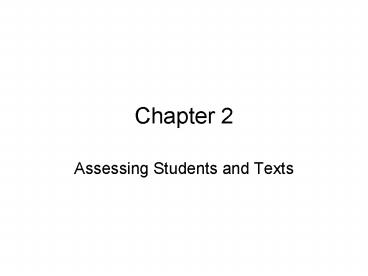Assessing Students and Texts - PowerPoint PPT Presentation
1 / 17
Title:
Assessing Students and Texts
Description:
A process of gathering and using multiple sources of information about students ... Tennessee Comprehensive Assessment Program. A multitude of tests ... – PowerPoint PPT presentation
Number of Views:149
Avg rating:3.0/5.0
Title: Assessing Students and Texts
1
Chapter 2
- Assessing Students and Texts
2
K-W-L
3
Assessment
- Instructional assessment is
- A process of gathering and using multiple
sources of information about students for
instructional purposes.
4
Approaches to Assessment
- High Stakes, Formal
- Issues and concerns
- Norm-referenced
- Criterion-referenced
- Authentic, Informal
- Work samples
- Checklists
- Interviews
- Rubrics
- Self-assessments
- Issues and concerns
5
Traditional Assessment Issues and Concerns
- Meeting standards
- Social promotion
- Developmental appropriateness
- Time spent on test preparation
- The snapshot effect
- High stakes for students and schools
6
Standardized Tests
- Formal
- Machine-scorable
- Often norm-referenced
- Permit comparisons of groups
- Used for program evaluation
7
Key Terms in Traditional Assessment
- Norms
- Raw scores
- Percentile scores
- Stanine scores
- Grade equivalent scores
- Reliability
- Validity
8
TCAP
- Tennessee Comprehensive Assessment Program
- A multitude of tests
- Criterion-referenced, not norm-referenced
- Based on State Performance Indicators (SPIs)
- Not in all subjects or content areas
9
Authentic Assessment
- Teacher as major tool
- Observation--time sample or interval
- Portfolios
- Checklists
- Rubrics
- Self-assessments
10
Activity
- Design a rubric
- Test your rubric
- Refine your rubric
- Feedback and discuss
11
Content Area Reading Inventories (CARI)
- Explain the purpose
- Introduce the text, guide silent reading
- Open or closed book?
- Discuss results
- Levels of comprehension
- Rates of comprehension
- Implications for instruction
12
Readability
- Readability formulas as rubber rulers
- Variables length (sentence complexity), and
vocabulary - The Fry Readability Graph
- Others
13
The Cloze Procedure
- Systematic deletion of words
- New material
- Closed book activity
- Synonyms dont count
- Below 60--will need guidance reading the text
14
Readability Checklist
- Understandability
- Usability
- Interestability
15
FLIP Strategy
- Friendliness
- Language
- Interest
- Prior Knowledge
16
K-W-L
- Revisit the K-W-L from the beginning of class
- Complete the L section
- Create a new graphic for K-W-L-S
17
(No Transcript)
























![[PDF] Health Assessment in Nursing Seventh, North American Edition Android PowerPoint PPT Presentation](https://s3.amazonaws.com/images.powershow.com/10076368.th0.jpg?_=20240711081)






